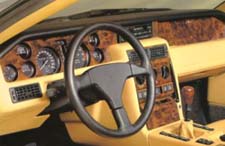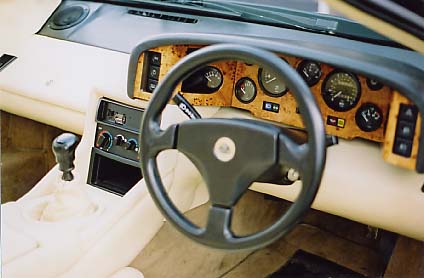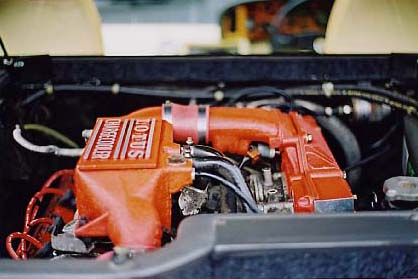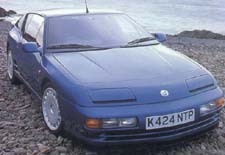LOTUS'S LAST STAND?
AUTOCAR 1992

Lotus's sole surviving
model, the Esprit, still has what it takes
to crush newer rivals from Renault and MVS.
Wales was like a film set clear blue skies, a mellow warmth in the air and sunshine glinting off the sharply raked windscreens of the trio of broad-shouldered supercars. Back at Hethel, home of Lotus, the future looked anything but bright. Unknown to us at the time, a storm was brewing that would make the outcome of our battle of the plastic powerhouses even more poignant.
The Excel may have died of old age, but the Elan was cut down in its prime, leaving Lotus with just the Esprit. We put the 16-year-old car up against Renault's revamped A610 and the little-known but highly respected MVS venturi 260 to determine who makes the best cut-price suitor to the court of Ferrari.
If looking, good and going fast were all that mattered, each of our plastic supercars could be an unqualified sales success. But prestige and price share equal billing, and if their combined British sales top 100 this year their makers will count themselves lucky.
Of the three, it's obvious which one comes from a mainstream manufacturer. Not only is the Alpine much cheaper — £37,980 against £47,790 for the Lotus and £47,979 for the MVS — but it's also roomier, boasting an extra pair of seats in the back, and has damn near as much beef in its boot: 250bhp to the Venturi's 260bhp and the Esprit's 264bhp.
Day one was to be a scratch-it-and-see exercise, a time for acclimatisation and forming initial opinions. With mid and rear-engined cars such as these, driving fast without comprehensively researching your subject first is asking for trouble.
The Renault, to no one's great surprise, had walked the opening rounds on the motorway, its superior refinement and fine all-round visibility putting to shame the Esprit's buzzy engine note and the venturi's peculiar inability to cruise smoothly at a constant speed. The A6 10 was scoring well in the looks-per-mile game, too, closely followed by the outrageously bewinged Esprit. Fewer people seemed to be interested in the pretty but less boisterous-looking MVS.


By the end of that first day, road test editor Frankel and I were all but convinced the A610 was best, less effort to drive quickly, more economical (about 20mpg compared with 18mpg for the Lotus and 17mpg for the Venturi) and seemingly every bit as fast, its ease seemed bullet-proof. The Esprit, having spent the '80s doing battle with Ferrari 308s and often as not winning, looked like it was going to be knocked clean out of the ring by a Renault. It reminded us of Ali being flattened by Larry Holmes.
Day two. Sliding down into the Esprit's cabin again, the driving position and controls don't seem as ridiculous as they did yesterday. It's still impossible to see the fuel gauge through the steering wheel, the minor switch location is a joke and the seat offers about as much under-thigh support as a stand-up French toilette. But it's better than any previous esprit. Tall drivers, like the 6ft 4ins Frankel, can now cover long distances in discomfort rather than numb agony, thanks to fractionally increased legroom, while the new tail-mounted surfboard now hints at allowing some rear vision.
It's still nothing like as coherent as the Renault's tidy but ultimately plain cabin, which sports the best driving position of the lot, even if the floor-hinged pedals still seem to try to be different for the sake of it. Nor is it a match for the hand-crafted, Connally-clad (£1243 extra) MVS cockpit, which is so much classier that it makes the other two feel like a Ford Escort inside.



I lead out of the car park in the MVS, gradually getting back in tune with the 2.8-litre pushrod V6 turbo's split personality. It may be essentially the same engine that powers the Renault, but MVS's modifications have turned it from an honest, hard worker into a fire-breathing powerhouse with well over 3001b ft of torque itching to let rip as proof. At 2000rpm the turbo bids me good morning, with a sound like a salvo of pea-shooters, and the Venturi lunges forward. So hard and so fast, in fact, that the other two are momentarily engulfed in a plume of dust, unable to match the MVS's hyperspace mid-range punch and immediacy of pick-up.
Eventually I lift off and allow the others to reel me in, but the Venturi has already made its point. For sheer 'squirtability' it has no rival here, tearing between 50-70mph in top in just 5.8secs, a full second inside the A6 10 and well over half a second in front of the Lotus. That's quick enough to leave anything this side of a Diablo in the gutter.
After the Venturi, the A6 10 seems almost sensible, and therein lies its problem. Genuinely rapid car though it is, the Alpine doesn't feel all that quick, not in the same all-or-nothing manner as the MVS. In truth it isn't as fast, but the real reason it appears so much less dramatic — less of a supercar, if you like — is the three-litre V6 turbo engine's smooth, quiet and even operation. Commendable traits under more ordinary circumstances, they act as a spoiler to the raw thrills factor that makes its rivals seem so special.


The Lotus takes longer to answer the call of your right foot, but when it does you'd better believe it can deliver a wallop that's stronger than all of them. And any difficulty you might have understanding just how quick it is can be laid to rest by the mind-tingling 4.7secs 0-60mph time we clocked — over a second up on the A610 and half a second quicker than the blistering Venturi. It doesn't run out of steam until the 7400rpm limiter pulls stumps, feeling more the genuine thoroughbred than either of the two French cars, even if its twin-cam 2.2-litre 16-valve engine is the worst sounding of the lot.
There are deeper problems than this with the Esprit, though. All three share the same Renault gearbox, but the Esprit's feels looser and more rubbery than the others. And then there's the brakes. Fine under mild pressure, the Esprit's anchors aren't as solid as they should be under heavy use, suffering from big fade on occasions when neither the MVS nor A610 raised a sweat.
But the steering — once an Esprit bugbear — is now magic in the right conditions. Tiresomely heavy at low speeds, it suddenly comes alive when you point the car's shovel nose at a Welsh mountain, channelling messages from the tyres to your fingers like Kim Philby to the Kremlin. You need a much firmer grip on the rim than in the other two assisted arrangements, and it's harder work. But, given that this allows a more intimate involvement with the workings of - the chassis and, consequently, a richer driving experience, that's a price well worth paying.
That said, the Lotus simply doesn't have the front-end bite of the other two, and in spite of recent front suspension modifications it still understeers too much. Compared with the MVS, which appears to suffer no understeer at all and has the sort of traction out of slow corners that makes your hair stand up on end, the Esprit can seem quite a handful on really narrow roads. But at least it's on steadier ground next to the A6 10, whose chassis lacks the involvement of the Lotus and the grip, turn-in, balance and pure agility of the Venturi.

By the time we left Wales, our thoughts of 24 hours ago had been turned on their head. The MVS still split the two — a place earned because its cabin and knockout punch made it special, even if its strangely uncommunicative steering stopped it from feeling like a bona fide supercar. But on that second day the A610 let slip something we could never have guessed from our initial drive. In its quest for outright ability it had sold its soul and left us chilly — something its predecessor, the intimately involving GTA, would never have done.
The Esprit, on the other hand, has sold out to no one. Yes, it's technically inferior to both its French opponents, slower than the MVS cross-country and requires more effort than the A610 to drive at the same speed. But it's the only one that smacks at supercardom. In the Venturi or A610 you recall a 10-mile stretch of road with a smile, but that's about as far as it goes. In the Lotus you remember each camber change on every corner with a grin that threatens to split your face in two. Which makes it a more memorable car than the French pair.
The Esprit, says Lotus, is not dead, merely resting. Ask Lotus Engineering and they will even build you one to special order. And it's developing power steering, better brakes and further cabin revisions for next year. Let's hope the result continues to recognise that in cars like these it's not how fast you get there that matters most, it's how much fun you have on the way.